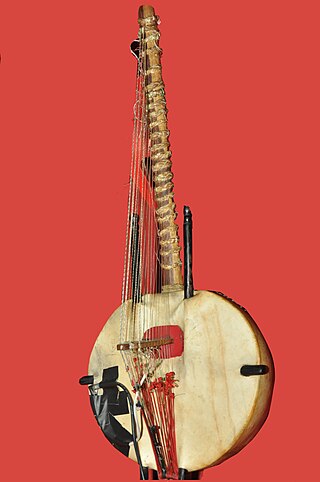
The kora is a stringed instrument used extensively in West Africa. A kora typically has 21 strings, which are played by plucking with the fingers. It combines features of the lute and harp.

A mandolin is a stringed musical instrument in the lute family and is generally plucked with a pick. It most commonly has four courses of doubled strings tuned in unison, thus giving a total of eight strings. A variety of string types are used, with steel strings being the most common and usually the least expensive. The courses are typically tuned in an interval of perfect fifths, with the same tuning as a violin. Also, like the violin, it is the soprano member of a family that includes the mandola, octave mandolin, mandocello and mandobass.
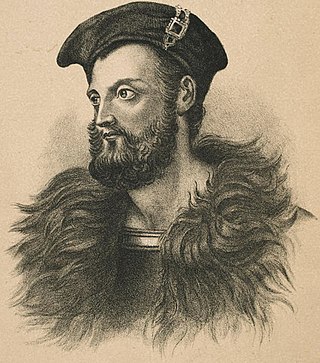
Owen Roe O'Neill was a Gaelic Irish soldier and one of the most famous of the O'Neill dynasty of Ulster. O'Neill left Ireland at a young age and spent most of his life as a mercenary in the Spanish Army serving against the Dutch in Flanders during the Eighty Years' War. After the Irish Rebellion of 1641, O'Neill returned and took command of the Irish Confederate Ulster Army. He is known for his victory at the Battle of Benburb in 1646.
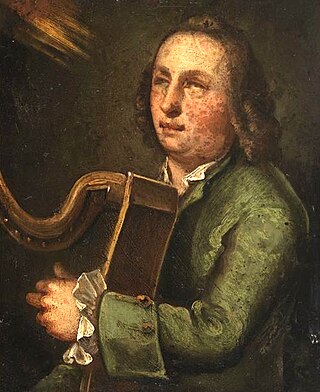
Turlough O'Carolan was a blind Celtic harper, composer and singer in Ireland whose great fame is due to his gift for melodic composition.
Thomas Robinson was an English Renaissance composer and music teacher, who flourished around 1600. He taught and wrote music for lute, cittern, orpharion, bandora, viol, and voice.

Sir Phelim Roe O'Neill of Kinard was an Irish politician and soldier who started the Irish rebellion in Ulster on 23 October 1641. He joined the Irish Catholic Confederation in 1642 and fought in the Wars of the Three Kingdoms under his cousin, Owen Roe O'Neill, in the Confederate Ulster Army. After the Cromwellian conquest of Ireland O’Neill went into hiding but was captured, tried and executed in 1653.

Confederate Ireland, also referred to as the Irish Catholic Confederation, was a period of Irish Catholic self-government between 1642 and 1649, during the Eleven Years' War. Formed by Catholic aristocrats, landed gentry, clergy and military leaders after the Irish Rebellion of 1641, the Confederates controlled up to two-thirds of Ireland from their base in Kilkenny; hence it is sometimes called the "Confederation of Kilkenny".
Thomas Connellan was an Irish composer.
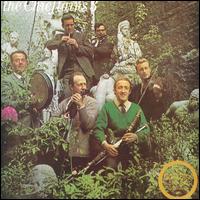
The Chieftains 3 is the third album released by the Irish musical group The Chieftains in 1971.
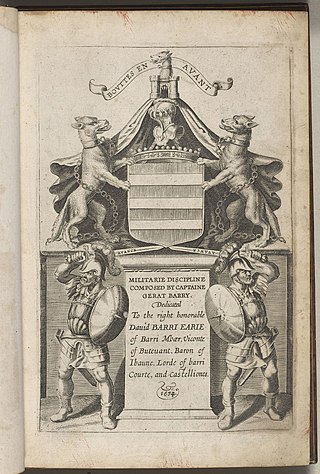
Garret Barry, also called Gerat, was an Irish soldier and military writer, who fought for Spain in the Eighty Years' War and then for the Irish insurgents in the Rebellion and the Confederate Wars. When young he left Kinsale at its surrender in 1602 for Spain where he took service, first as marine in the Atlantic Fleet and then in the Army of Flanders. While in Spanish service, he fought at the Siege of Breda in 1624/1625. He retired with the rank of captain in 1632. Returning to Ireland he was at the Rebellion appointed general of the insurgents' Munster Army. He took Limerick in June 1642 but was defeated at Liscarroll by Inchiquin in September. He was confirmed as General of the Munster Army by the Irish Catholic Confederation but was in practice superseded by Castlehaven in 1643.

Francis O'Neill was an Irish-born American police officer and collector of Irish traditional music. His biographer Nicholas Carolan referred to him as "the greatest individual influence on the evolution of Irish traditional dance music in the twentieth century".

John James is known, primarily, as a solo acoustic fingerstyle guitarist, composer and entertainer. His popular appeal is attributed to his ability to entertain with musicianship and humour, a blend of presentation and performance that has brought the art of the fingerstyle guitar, from the dedicated guitar fans to the appeal of a wider audience.
Presented below is a chronology of the major events of the Irish Confederate Wars from 1641 to 1653. This conflict is also known as the Eleven Years War. The conflict began with the Irish Rebellion of 1641 and ended with the Cromwellian conquest of Ireland (1649–53).
Folk baroque or baroque guitar, is a distinctive and influential guitar fingerstyle developed in Britain in the 1960s, which combined elements of American folk, blues, jazz and ragtime with British folk music to produce a new and elaborate form of accompaniment. It has been highly important in folk music, folk rock and British folk rock playing, particularly in Britain, Ireland, North America and France.
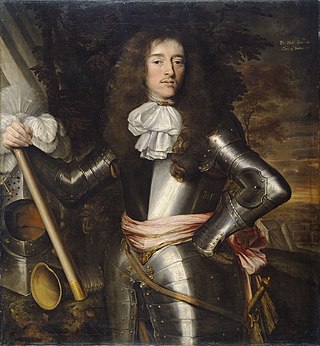
Murrough MacDermod O'Brien, 1st Earl of Inchiquin, was an Irish nobleman and soldier, who came from one of the most powerful families in Munster. Known as Murchadh na dTóiteán, he initially trained for war in the Spanish service. He accompanied the Earl of Strafford into Leinster on the outbreak of the Irish Rebellion of 1641 and was appointed governor of Munster in 1642. He had some small success, but was hampered by lack of funds and he was outwitted the Irish leader, Viscount Muskerry, at Cappoquin and Lismore. His forces dispersed at the truce of 1643.

The Chieftains Live! is the first album by the Chieftains which was recorded live. It was recorded on tour in December 1976 at Symphony Hall in Boston and Massey Hall in Toronto.
Arthur O'Neill was an Irish harper, a virtuoso player of the Irish harp or cláirseach: he was active during the final decades of its unbroken instrumental tradition in the later 18th and very early 19th century. He was closely associated with Edward Bunting, and the Belfast Harp Society's ultimately unsuccessful attempt to preserve the instrument, attending the Belfast Harper's Assembly and serving as the Society's harp tutor until 1813. He is best known for his lively and humorous memoir, collected by Bunting, which contained many reminiscences of famous harpers and of the environment in which they played.

"The Lament for Owen Roe" is a traditional Irish ballad dating from the nineteenth century. With a mournful tune, based on an eighteenth-century composition called Lament for Owen Roe O'Neill by the harpist Turlough O'Carolan, it is a lament for the death of Owen Roe O'Neill. Its lyrics were written by Thomas Davis and draw on the tradition of romantic nationalism which was at its height during the era.
The siege of Dublin took place in 1649 during the Irish Confederate Wars. It was a failed attempt by combined Irish Royalist and Confederate forces to capture the capital of Dublin which was held by English Republican forces under Michael Jones. It was part of a strategy by Duke of Ormonde, head of an alliance loyal to Charles II, to seize the remaining foothold of Ireland still under the control of the London Parliament.
Richard O'Farrell was an Irish soldier of the seventeenth century most notable for his service in the Irish Confederate Wars from 1642 to 1651. He rose to the rank of Lieutenant General.











